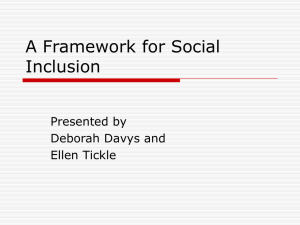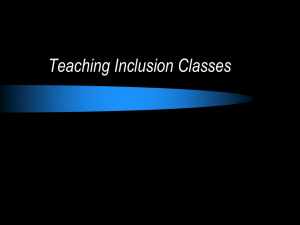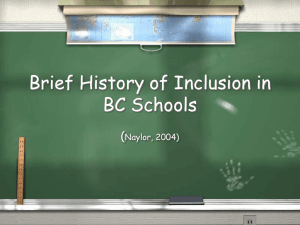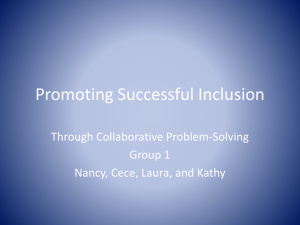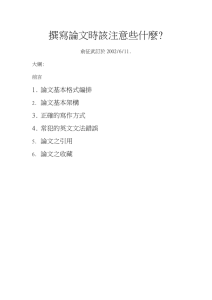here - Social Justice Initiative
advertisement
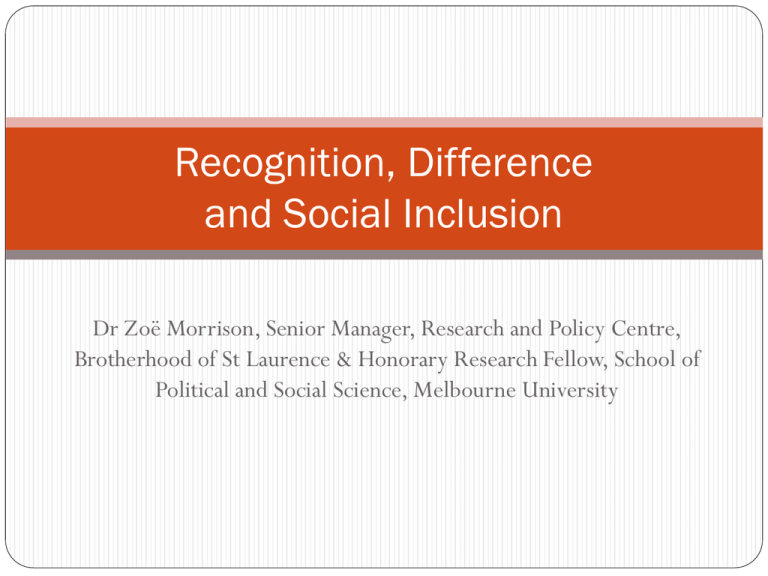
Recognition, Difference and Social Inclusion Dr Zoë Morrison, Senior Manager, Research and Policy Centre, Brotherhood of St Laurence & Honorary Research Fellow, School of Political and Social Science, Melbourne University Contents Introduction Social justice, recognition and redistribution Different aspects of recognition Social inclusion and difference Social inclusion policy examples from a recognition perspective Social justice, recognition and redistribution Social inclusion and social justice – a multi-dimensional approach ‘It’s about income, but about more …’ (Blair, 1997) ‘National economic and social policies will no longer be working at cross purposes’ (Gillard, 2008) Fraser articulated a vision of how economic and cultural factors create injustice together, and how social justice requires both redistribution and recognition ‘Justice today requires both redistribution and recognition’ (Fraser, 2003, p.9) Eg economic and cultural aspects of sexism , racism and poverty Social justice, recognition and redistribution Debate has raged in political-philosophy about the relationship between recognition and redistribution (eg Fraser 1995,Young 1997, Phillips 1997, Butler 1998, Fraser & Honneth 2003) Fraser argues that certain forms of a politics of recognition can act counter certain politics of redistribution Others argue that rather than being a distraction from or in competition with a politics of redistribution, a politics of recognition is instead complimentary and even a necessary part of its success Different aspects of recognition ‘Inter-subjective’ recognition (Honneth 2001, Taylor 1994) When a person is insulted or degraded, they are denied recognition, and positives understandings of themselves are impaired. Misrecognition and non-recognition are forms of oppression because they imprison someone in a false, distorted and reduced mode of being. People who are members of stigmatized groups in society, and who experience this stigmatization repeatedly, internalize negative self-images. Beyond being simply insulting this can inflict a ‘grievous wound’, saddling people with crippling selfhatred. Due recognition is not just a courtesy, but a vital human need Different aspects of recognition Recognition as ‘participatory parity’, and misrecognition as ‘status injury’ (Fraser, 2000) ‘To be misrecognised is not only to be thought ill of, looked down upon or devalued in people’s attitudes, beliefs or representation. It is being denied the status of full partner in social interaction, as a consequence of institutionalized patterns of cultural value that constitute one as comparatively unworthy of respect or esteem’ (2000, p.56) ‘To be misrecognised is not to suffer distorted identity or impaired subjectivity as a result of being depreciated by others. It is rather to be constituted by institutionalized patterns of cultural value in ways that prevent one from participating as a peer in social life’ (2003, p.29) Eg participation of women in the labour market (Fraser & Liakova, 2008) Different aspects of recognition Fraser argues against the ‘self-realization’ model in preference to the ‘status model’ Others argue Fraser too readily dismisses intersubjective recognition, its salience to redistribution and social justice overall. Eg advocacy for poorly paid child-care workers (MacDonald & Merrill, 2002) – the role of redistribution, institutional recognition and inter-subjective recognition So how do these social justice concepts or redistribution and recognition relate to social inclusion policy and thinking? Social justice and social inclusion policy Discussion to date has mostly focused on redistribution Little explicit attention been paid to the politics of recognition and social inclusion - perhaps surprising, given a defining feature of social inclusion has been its emphasis on participation (Room, 2005). Institutional recognition issues are directly relevant to the involvement of socially excluded people in their community and local areas (see Barnes, Newman & Sullivan, 2007) Also, some work on the extent to which social inclusion discourse and policy reflect the concerns of particular social groups –although this has not yet been expressed in recognition terms Analyzing social inclusion policy Participation and neighbourhood renewal Lister (2008) looked at ways to build the capacities of people who experience poverty to be able to participate directly in decision making that affects their lives. Seems to be a matter of ‘institutional recognition’, but Lister also implicitly acknowledges the relevance of ‘intersubjective’ recognition. Further analysis suggests a greater role of inter-subjective recognition in the effectiveness of these participatory projects Analyzing social inclusion policy Neighbourhood renewal and participation Social exclusion and neighbourhood renewal policy – Single Regeneration Budget, UK Policy mechanisms mitigated against greater and more diverse local involvement Within the broader context of ‘Bringing Britain Together: A National Strategy for Neighbourhood Renewal’ Discourses of shame and disgust form a continuum of misrecognition Analyzing social inclusion policy ‘Jobless families’ and workforce participation ‘Jobless families’ have had particular emphasis in the Australian SI agenda, and the well-being of children is an important part of it, particularly in relation to improving child poverty. Agenda risks not adequately recognising the full range of factors that contribute to children’s equality, well-being and social inclusion- recognition issues need to be integrated with a more conventional economic analysis Analyzing social inclusion policy Homelessness and domestic violence Homelessness a paradigmatic SI issue - DV now recognised as the largest single cause of homelessness in Australia (FaCSIA, 2008) Different experience of DV create different needs when it comes to homelessness policy solutions - women who have exp violence throughout their lives are able to reestablish their lives require diverse, long-term supports Inter-subjective recognition issues associated with the experience of violence play a ‘gate-keeping’ role to the success of long-term housing solutions Social inclusion and difference Perhaps social inclusion’s limited ability to accommodate difference is not surprising Social inclusion is not just a suite of policies or a new way of doing governance - it is also a vision, set of values and way of seeing the world that is necessarily normative Conclusion For a stronger philosophical under-pinning to social inclusion thinking, and better social inclusion policy, we need a greater recognition of recognition issues. If we are to better encompass diversity and difference within the conceptualization of social inclusion, and its policies, social inclusion as a normative concept will need to be challenged, stretched, and re-invented. At its best, the concept of social inclusion will grow to take more diverse perspectives into account, and better reflect the multi-dimensional nature it aspires to.



